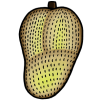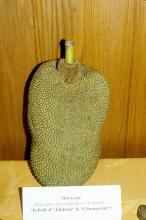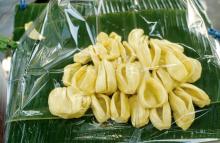Maturity and Quality
Jackfruits can reach very large size (as much as 90 cm long, 50 cm wide, and 25 kg in weight), depending on the cultivar, production area, and the fruit load on the tree. Color change from green to yellow to brown is used as an indication of maturity and ripeness stages. Optimum harvest for long-distance transport is when the fruit changes color from green to yellowish-green. Fruits are harvested with a portion of the stalk attached to be used in handling them.
- Fruit size
- Shape
- Color
- Freedom from defects (sunburn, cracks, bruises) and decay
Jackfruits contain 25-30% carbohydrates (fresh weight basis) including about 15-20% starch in unripe fruits that is converted to sugars (sucrose + glucose + fructose) in ripe fruits.
The unripe fruit is used as a starchy vegetable, either boiled or roasted, and when ripe it is used as a dessert fruit. Average acidity is 0.25% citric acid.
Jackfruit fruitlets are commonly sold in producing countries as a fresh-cut product.
Postharvest Handling and Storage
13 ± 1°C (56 ± 2°F); potential postharvest-life = 2-4 weeks, depending on cultivar and maturity stage.
20-25 (preclimacteric) to 50-55 (climacteric peak) ml CO2/kg·hr at 20°C (68°F)
To calculate heat production multiply ml CO2/kg·hr by 440 to get Btu/ton/day or by 122 to get kcal/metric ton/day.
Exposure to 100ppm ethylene for 24 hours accelerates ripening of mature-green jackfruits at 20-25°C (68-77°F). During ripening, the starch is converted into sugars, the pulp color changes from pale white or light yellow to golden yellow, and the fruit aroma becomes intense.
85-95%
No published information.
No published information.
Disorders
Chilling Injury. Jackfruits exposed to temperatures below 12°C (54°F) before transfer to higher temperatures exhibit chilling injury symptoms, including dark-brown discoloration of the skin, pulp browning and off-flavor development, and increased susceptibility to decay.
Pathological disorders usually follow mechanical and/or chilling injuries. No published information on postharvest pathogens of jackfruits.





